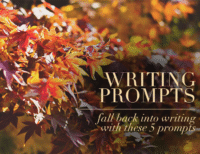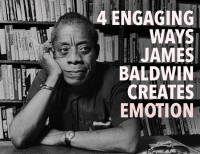The standard rule is this: “show, don’t tell.” Instead of telling your reader that Jane is “sad,” show the reader by describing Jane’s demeanor, her tears, etc. You're supposed to allow the reader to experience Jane’s sadness with her.
But in a 80,000 word manuscript, chances are you’ll do at least some telling. The temptation to “tell” usually arises when you need to share background information, summarize events, or provide context for what's happening.
4 Ways to Tell, Not Show
I think there’s a way to break the “show, don't tell” rule (occasionally!) without taking away from the reader experience. Here are four techniques you can try:
1. Do it in the third person
Originally my manuscript alternated between the points of view of two characters, each speaking in the first person. As a result, my characters would sometimes randomly start explaining the history of a place or providing the context for a decision he or she made.
My editor labeled these sections as “too expositiony” and said that real people don’t talk that way. Knowing that it was important to me to include the information, she suggested writing a few chapters in the third person.
It worked! In addition to enabling me to provide important context and background to the reader, the occasional third-person chapters provided a welcome change of pace. I enjoyed writing them, and I enjoy keeping the reader on his or her toes.
2. Or, do it in the character’s voice
If you’re sticking to a first-person point of view, and are dying to “tell” something, at least do it in your character’s voice/from your character’s perspective.
For example, one character may describe a town with nostalgia, focusing on smells or specific places that trigger childhood memories. Meanwhile, another character, who is more of an outsider, may describe the same town by telling the reader what he’s “heard” about the place or focus more on what she’s seeing right in front of her.
Just make sure to do it in a way that is authentic to the character.
3. Keep it brief
Set the scene in a paragraph. Provide background in a sentence, or even a clause. Or, if you plan to dedicate a chapter to “telling,” keep that chapter to a page or two.
Remember, “telling” should be the exception, not the rule.
4. Have fun with it!
Just because you’re explaining something to the reader doesn’t mean you have to be boring. Hint at a mystery. Share something with the reader the characters don’t know. Tell a story.
Show, Don't Tell . . . But Sometimes, Tell
You'll find that a lot of writing “rules” are more like helpful guidelines. Don't be afraid to play around with them and discover what works for your story. When will you choose to tell rather than show?
Do you always adhere to “show, don't tell,” or are you ever tempted to “tell” instead of “show”? Let us know in the comments.
PRACTICE
Take fifteen minutes to provide background or context for something you're writing. Use one (or more!) of these four techniques to communicate the information effectively.
When you're done, share your writing in the comments section, and be sure to leave feedback for your fellow writers!







I am new to writing and reading the four tips was interesting but I need examples of these tips to understand better. It is not clear to me. Also, I am trying to find good info examples that show what you are saying using the 5 senses. My friend has written a manuscript and sent it to be published but after months, no reply. I read part of her manuscript and it is mostly telling. I cannot get into the story like I would like too but don’t know how to explain to her to revise it. I have a double challenge as it is written in french, although I am french, I think in english. Any tips? As for me, I want to grasp the audience when I write and be humorous about it. That is why it is important to show and not tell.
Hi, I’ve read your comment and if you agree, you can share some pages with me. I’m a french writer and I also write english but not as a native or bilingual. If I can help… I write blogs and I released my first novel 10 months ago, readdy to write my second novel. I think that giving emotions to our readers in very important when we write fictions. I like to describe but I love methaphores and comparisons.
So keep on and don’t feel discouraged. We are on our way 🙂
Merci Annie. I would like to write a flash fiction mixed with english and french and be humorous. I like to use metaphor , simile, alliteration. I love playing with words mostly. I don’t know if I am a story teller but I want people to have fun when they read my short book. I would say their tongue could twist as they read if you know what I mean. I want to be able to use all 5 senses. If you have a website or book that give lots of examples using all 5 senses. When I read books I tend to analyse the books or correct it ;o)
Hi, I am trying to achieve this very idea in my new novel. I am using dream sequences to tell the back story, I hope it works! Mind you this is draft one :
(This part is Italicized – that didn’t cross over in the comments, but in the book it’s how you know he’s dreaming)
Her body warm and pliable against his and he felt his heart overflowing with love for her. He never would have imagined that love was a real thing until he met Helen. He pulled her tight to his chest, and his lips lingered over her soft skin, as he allowed her clean aroma to fill his head, a sense of dread entered his mind.
This time Finnegans eyes flew open. Once again he was back in his bunk. How do they do that? He sat up and checked himself over, he had no lacerations or bruises.
“Goddamnit Helen, why did you have lose it now?”
I find it impossible not to include some telling, because it’s historical fiction. I try to limit it and find other ways to show the information, such as a conversation.
I find it funny to think how I have always been TOLD to show not tell. When Anton Chekhov first raised this in his memoirs he SHOWED the concept like this: “Don’t tell us that the moon is full. Show us instead the glint of light off broken glass.”
In my current work-in-progress I have just written a scene that introduces Beatriz, one of my main antagonists. I want to put her personality across along with one of her inner demons, the fact that she really wants to go back to being the scientist she once was, instead of the bureaucrat she has become. Here, she recalls the time, early in her career as an experimental physicist, where she, the ‘rookie’ of the group, had noticed something in some images that had profound meaning, but which the rest of her team had failed to see. I call this “showing through telling”:
They’d found it too. No, actually, she’d found it. There had been a definite series of wisps in the images. The rest of the team — the entire rest of the team — had actually looked and failed to notice the wisps. Her rookie eyes had noticed what so many seasoned eyes had missed. She and she alone, for the few minutes before she just had to tell someone, she had been the only human being in all of history up to that point, who knew that those wisps — and all that they signified — actually existed. The feint, neatly structured wisps could only have been diffracted axions, dark matter that had laid down tracks showing that they had traversed the chamber as a wave of quantum probability. The subtle, little wisps showed trajectory deflections proving that dark energy and only dark energy could have been their source. As Hwang and Ryeom, et al had predicted.
I think I do both in my writing.
Great post!
Something I’ve found is that readers will usually forgive you for Telling anything EXCEPT a major, consequential choice. If you Tell a choice (especially one related to the protagonist’s main goal and pursuit), then you’re skipping the story, and that’s what the reader is here for.
But if you “cut the fat” to get to the good stuff (I.e., the choices, the action, the consequences), and then do your best Showing, the reader might actually love you for it. This shows your ability to focus on the story’s main event, rather than “showing everything,” which bog things down or get off the main topic, which many readers don’t enjoy.
Thanks for sharing! This is great information (and freedom) that we all need!
I “tell” too much. My background as a journalist gets in the way with my fiction writing sometimes. The plus side is that I tend to be concise due to that training. It’s been drummed into my brain to use one word when it will do instead of several.
Miss Lumpy was a fixture in the little community of neighbors on Broad Haven Road. On Halloween, Miss Lumpy wore the same witch costume that she had been wearing for years: pointy hat, knee-length dress with tulle skirt, fake wart, striped socks, and press-on talon fingernails. Her hair hung from her head wrapped with string. She decorated her porch with candles and spider webs. Trick-or-treaters found their treats in the large cauldron hung over a flame in the front yard. Miss Lumpy laughed when the children, and adults, tried to take her treats from the hot cauldron. She danced a gleeful dance when neighborhood boys and girls ran screaming to their parents. It had been Miss Lumpy’s Halloween ritual for more than twenty years.
But Miss Lumpy wasn’t a cackling, evil spell kind of witch. Her pointy hat was bright yellow, the stripes on her socks were rainbows, and her tulle skirt was a soft prom-dress pink. Even her talons were a friendly sky blue. Her long, once chestnut, but now grey, hair was worn in dozens of thin braids; into each braid, Miss Lumpy had woven a colored ribbon of tiny bells. Every move she made was accompanied by tinkling music. The candles on the porch were birthday candles, contributed after each birthday party in the neighborhood. Garish spider webs, crocheted like Joseph’s coat from collected remnants of yarn and string, decked the rails of the porch, lit by the high wattage bulbs in each of the two ceiling fans.
In the front yard, midst the rock-lined flower gardens, over a gas camp stove, hung a black cast iron kettle, filled with boiling oil. Miss Lumpy dropped dollops of sweetened dough into the oil, scooped out the doughnuts, and sprinkled them with cinnamon and sugar before letting them cool on a rack covered with paper towels. The balls of dough had a crisp outer crust and a sweet chewy interior. The cinnamon and sugar coated the doughnut with the taste and scent of fall. She laughed giddily when the children, impatient and eager, tried to snatch a doughnut before it was completely cool. There was nothing scary about her laugh; her laugh was a fluid, flowing arpeggio rising in pitch from middle C. As Miss Lumpy danced around the kettle, moving with grace from goopy dough, to hot oil, to sugar and cinnamon, the children ran to their parents with paper bags filled with the hot sweet goodness of fresh “Lumpy balls,” the once a year treat from their beloved Miss Lumpy.
I’ll give it a try, but I’m still a tiny bit confused on how to do it. Feedback would be extraordinarily appreciated!
‘As we enter the town, I try not to think of Spencer telling me never to show my face to her again. I see her face in every shop window (goodness knows we explored every nook and cranny of the village), and I hear her bouncing footsteps in those of every person who passes by. I missed this town, and Spencer too, not that I’ll ever say it out loud.’